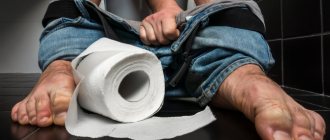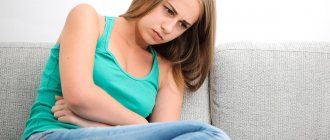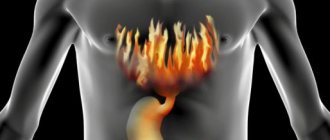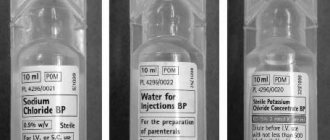The functioning of the intestine directly depends on its peristalsis and the composition of beneficial microflora. When these two components deviate from the norm due to illness, poor nutrition or lifestyle, a person begins to experience problems with stool (diarrhea, constipation), bloating, heartburn, increased gas formation in the intestines, belching and other unpleasant symptoms.
How to restore intestinal function if you encounter something similar, and is it possible to do this in principle when the problem has become chronic?
In the vast majority of cases this is possible. The main thing, starting from the cause of the disorder, is to eliminate factors that adversely affect the functioning of the digestive system and create all the conditions for the formation of normal intestinal microflora.
Restoring the functioning of the gastrointestinal tract after abdominal surgery
Any surgical intervention entails unpleasant consequences. First of all, this affects the functioning of the intestines. Anesthesia, antibacterial therapy and painkillers can lead to disruption of peristalsis, intestinal microflora and food digestibility, exacerbation of chronic ailments of the gastrointestinal tract.
During abdominal operations, intestinal adhesions often form, which also adversely affects its functioning.
After surgery, the intestines will be restored:
- a diet specially selected by a doctor;
- course of treatment of dysbiosis with probiotics and prebiotics;
- developing and maintaining a proper diet;
- taking enzymes and motor regulators;
- phytotherapy;
- therapeutic and health-improving physical education.
Drug treatment restores intestinal function only temporarily; after discontinuation of the drug, problems usually return. Therefore, it is necessary to develop the correct diet and daily routine, and then stick to it.
To prevent the formation of adhesions in the intestines, daily exercise, walking and, if possible, an active lifestyle are recommended.
How to establish normal bowel movements after long-term use of laxatives?
People suffering from constipation often abuse laxatives, which leads to distension of the rectum, its hypotonicity and, as a consequence, chronic constipation.
To get rid of constipation and restore intestinal motility, it is necessary to adjust your diet and eliminate foods that slow down intestinal motility from your diet. In addition, you should include more liquid and food that stimulate intestinal motility.
The entire daily volume of food per day should be divided into at least 4 meals, the amount of liquid consumed (preferably drinking water) should be at least 1.5-2 liters per day. It is advisable to choose bread from coarse flour, or with the addition of bran. Porridge should be prepared from millet, oatmeal, buckwheat or pearl barley.
Also, your diet should include a large amount of vegetables (zucchini, beets, carrots and pumpkin), fruits (apples, pears, kiwi, figs), berries and dairy products.
Products that cause increased fermentation in the intestines (legumes, cabbage, grapes, etc.), containing essential oils (radish, garlic, turnips, etc.) and tannins (jelly, strong tea) are not recommended for consumption.
Drug treatment
Before choosing a laxative, you should try to restore bowel function without medication. To do this, it is recommended to increase the amount of foods with coarse dietary fiber in the diet, drink enough liquid, at least 30 ml per kilogram of weight. Most patients manage to get rid of constipation within a month if they follow this regimen.
If these methods do not bring results, the patient is prescribed laxatives that interfere with the absorption of fluid from the intestine. The food bolus remains voluminous and loose. Feces do not injure the intestinal mucosa; they move better through the gastrointestinal tract and are eliminated without problems. For long-term chronic constipation, medications are prescribed that irritate the intestinal walls and increase peristalsis.
Lactulose-based drugs are preferable as laxatives. They have a gentle effect and do not cause dehydration. This group includes the drugs Duphalac, Normaze. Products with lactulose improve your own microflora, suppress pathogenic microorganisms, and can be taken for a long time.
Enzymes Pancreatin, Panzinorm, Festal are prescribed if particles of undigested food are found in the stool. They regulate the composition of intestinal microflora Hilak forte, Linex, Acipol. While taking them, electrolyte balance and vitamin synthesis are restored.
If constipation is associated with liver dysfunction, hepatoprotectors are added to treatment: Karsil, Liv 52, Essentiale. Antispasmodics Motilium, Trimedat eliminate flatulence, nausea, vomiting, and relieve pain. They increase sphincter tone and enhance intestinal motility.
Restoring the balance of intestinal microflora after taking antibiotics
Taking antibiotics used in the treatment of inflammatory and other diseases is often accompanied by inhibition of beneficial microflora in the intestinal tract and dysbiosis.
To restore the bacterial balance and improve the functioning of the gastrointestinal tract after antibiotics, prebiotics and probiotics are usually prescribed, proper nutrition and an active lifestyle are recommended.
Treatment of dysbiosis with prebiotics and probiotics is carried out over a long course. Usually 1-2 courses are enough to restore the balance of beneficial bacteria. It is also necessary to maintain a balanced diet.
It is very important to drink plenty of fluids, include vegetable fats (olive and sunflower oils) in your diet, and minimize the amount of baked goods, spicy and fried foods.
It is better to prevent any disease than to treat it. Therefore, probiotics and prebiotics are often prescribed along with antibiotics. You can also use folk remedies to prevent the occurrence of dysbacteriosis during the treatment period.
The following are excellent preventive measures:
- collections of medicinal herbs;
- vegetables;
- dog-rose fruit;
- fruits;
- sour berries;
- garlic;
- own fermented fermented milk products (yogurt, yoghurt, kefir).
Folk recipes
You can also use popular advice. Vegetable oils have a laxative effect:
- olive;
- linen;
- Vaseline;
- castor
They are taken in the morning on an empty stomach, but not more than three days. To restore intestinal function, decoctions of herbs such as senna, St. John's wort, chamomile, and sage are prepared. You can use each plant separately or prepare a medicinal collection.
Two tablespoons of the medicinal mixture are placed in a thermos and 800 ml of boiling water is poured. Leave for several hours, drink half a glass 30 minutes before meals.
To improve metabolism, prepare a paste from 300 g of aloe stems and 500 g of honey, add 0.5 liters of red wine. The mixture is consumed one teaspoon at a time for a week. Then a tablespoon three times a day, half an hour before meals. The course of treatment is two weeks; if necessary, it can be extended to a month.
Normalizing stool after childbirth
In the last months of pregnancy, a woman's intestines are in a compressed state, which makes it difficult for them to function properly. Therefore, the tone of the intestinal walls weakens and peristalsis is disrupted.
Most often, to restore intestinal motility after the birth of a child, following a proper diet is enough. Food should contain fiber, fats, proteins, micro- and macroelements, vitamins. It is better to avoid spicy and fried foods.
Products that improve intestinal motility:
- vegetables (carrots, beets, zucchini, broccoli, etc.);
- fruits (apple, pear, plum, etc.);
- dried fruits (dried apricots, dried prunes);
- vegetable soups;
- bread made from wholemeal flour or with bran;
- dairy products.
The rapid recovery of the body and the functioning of the intestines are also facilitated by therapeutic exercises and abdominal massage. The following video will show you how to perform them:
Restoring the intestines after diarrhea
The causes of diarrhea can be acute intestinal infections, poisoning, dysbacteriosis, and side effects when taking medications. Diarrhea leads to dehydration, washing out the intestinal microflora and colonizing it with pathogenic microorganisms, and disrupting the water-salt balance.
To restore the intestines during the first 24 hours after diarrhea, fasting and drinking plenty of fluids are recommended. On the second day, a strict diet of low-fat meat broths and steamed food is prescribed.
In this case, folk remedies will also help restore the intestines. To restore normal stool, it is recommended to drink green tea, decoctions of rosehip, quince, bird cherry and blueberry. On day 4 you can include vegetables, meat and fish dishes, cereals and dairy products in your diet.
Bifidobacteria contained in probiotics and fermented milk products will help normalize the intestinal microflora. Recommended fermented milk products: yogurt, fermented baked milk, kefir, cottage cheese. It is recommended to follow a gentle diet after suffering from diarrhea for at least 2-3 weeks.
At a time when medicine has long been able to defeat such terrible diseases as smallpox, typhus, plague, cholera, numerous intestinal ailments are a scourge in the modern world. If you start treatment on time, you can avoid complications. But very often people turn to doctors when surgical intervention is no longer possible. After this, you will have to think about how to restore the functioning of the gastrointestinal tract.
Other tips
Massage has a good effect for prolonged constipation. To improve peristalsis, the stomach is stroked clockwise, without pressure, for a minute. Then they do rubbing and kneading. Massage is best done in the morning and evening. You can stimulate your intestines by massaging your little fingers daily.
When urgent help is needed, an enema is done with a hypertonic solution; oil – if constipation is mild. A microenema gives a good effect. Microlax for constipation is suitable for all age groups. It is simple and easy to use. The medicine activates the flow of fluid to the intestines, stool becomes soft, and the process of defecation begins within 15 minutes.
Hard stools, painful bowel movements, constipation - all this indicates problems in the body. You need to respond to such signals in a timely manner, otherwise constipation can lead to a serious illness. You can cope with constipation on your own, but you need desire, persistence and discipline. And if you reconsider your life principles and habits, you will be able to completely avoid such a problem forever.
- How to restore the intestines after colonoscopy with Fortrans
- How to restore intestinal flora after diarrhea - Pain in the intestines
- Discharge after hysteroscopy of endometrial polyp with curettage
- Side effects after breast biopsy
Types of operations
- Laparotomy. The doctor makes an open incision in the abdominal cavity and muscles, removes and cleans the organs and then stitches them up. This method is the most commonly used, but also dangerous - complications can occur due to the large resection area and blood loss. Recovery of the body takes from 1 week to a month, depending on the size of the affected area and the complexity of the particular case.
- Laparoscopy. This procedure takes place for small tissue lesions. The surgeon makes from 1 to 5 incisions through which he inserts a device in the form of a special tube with a camera. Thus, the doctor can see the condition of the organ and then operate.
What ailments bring you to the surgeon's office?
- advanced hemorrhoids;
- benign and malignant tumor;
- polyps;
- mesenteric infarction;
- Crohn's disease (chronic inflammation);
- obstruction;
- tissue necrosis.
When drug therapy fails, these diseases are treated by incision or removal of the problem area. If the length of the rectum has been shortened, the doctor can remove the bone fracture to the abdominal wall. There is a difficult case when the surgeon has to cut off a large part of one of the sections of the gastrointestinal tract. Then the patient is prescribed to eat special mixtures throughout his life. The more difficult the task, the more difficult it will be for the body to recover, and its owner will have to get used to the new functioning of the digestive tract. For a person, this is a great emotional burden, which can lead to nervous breakdowns. In this case, family support and stress-reducing medications are needed; often in such cases, doctors advise consulting a psychotherapist.
Site search
If you did not find the information you need among the answers to this question, or your problem is slightly different from the one presented, try asking an additional question to the doctor on the same page, if it is on the topic of the main question. You can also ask a new question, and after a while our doctors will answer it.
The medical portal website provides medical consultations through correspondence with doctors on the website. Here you get answers from real practitioners in your field. Currently, on the site you can get advice in 43 areas: allergist, venereologist, gastroenterologist, hematologist, geneticist, gynecologist, homeopath, dermatologist, pediatric gynecologist, pediatric surgeon, pediatric endocrinologist, nutritionist, immunologist, infectious disease specialist, cardiologist, cosmetologist, speech therapist, Laura , mammologist, medical lawyer, narcologist, neurologist, neurosurgeon, nephrologist, oncologist, oncourologist, orthopedist-traumatologist, ophthalmologist, pediatrician, plastic surgeon, proctologist, psychiatrist, psychologist, pulmonologist, sexologist-andrologist, dentist, urologist, pharmacist, herbalist, phlebologist , surgeon, endocrinologist.
We answer 97.89% of questions.
Stay with us and be healthy!
Laxatives are supposed to restore stool, but in reality we often have to solve the opposite problem: how to restore stool after laxatives.
What are the possible consequences of resection?
To normalize the functioning of the gastrointestinal tract after surgery, rehabilitation is necessary, as intestinal motility is disrupted. This is a wave-like contraction of the muscles of the organs responsible for moving digested food from the upper sections to the outlet. The state of digestion depends on motility: difficulty or, on the contrary, too rapid passage of feces, absorption of nutrients worsens. Waste products are not completely eliminated and the process of fermentation and decay begins, which has a beneficial effect on the proliferation of bacteria and parasites.
Instability of peristalsis occurs due to surgery and subsequent procedures, such as the patient taking antibiotics, which upsets the balance of bacteria in the gastrointestinal tract.
How to improve the functioning of the stomach and intestines after surgery
The rehabilitation time directly depends on the volume of surgical operations and the place where they were performed. An important component in this process is the patient's general health, his age and how carefully he will follow the doctor's recommendations. To avoid complications, the doctor prescribes a specific diet for each case, because food will immediately come into contact with the diseased area.
The patient needs to adjust physical activity and take hygiene seriously. Treat the suture and bone fracture in a timely manner if part of the organ has been removed.
Physical activity
A sedentary lifestyle leads to a decrease in muscle tone, weakening not only the abdominal muscles, but also the intestines. To avoid this, feasible but regular exercise is necessary. You can go jogging, swimming, fitness or aerobics.
A physical therapy doctor will help you choose a set of exercises. It is best not to do this yourself, since the optimal range of movements depends on the patient's age, weight and physical fitness.
To improve peristalsis, the following simple exercises are recommended.
- While lying down, pull your stomach in and out for 1 minute.
- Perform the same exercise on one side and the other.
- Movement of the legs, simulating riding a bicycle.
To combat chronic constipation, morning exercises are mandatory. To improve blood circulation in the intestinal area, it is enough to bend, squat, and run in place. Cycling or just walking is beneficial.
Recovery methods
There are several methods for normalizing intestinal function after surgery, but for better results it is necessary to combine them into a complex.
Breath control
These exercises can be done immediately after the intervention, as they do not require much strength. Under the supervision of a doctor, the patient inhales and exhales. This helps, especially after severe cases, to feel less pain and prevent inflammation in the lungs. Improper execution can cause nausea and dizziness.
Physical therapy
Gymnastics has a beneficial effect on blood circulation, muscle tone and tissue healing. Any activity stimulates the production of endorphins, which is absolutely necessary for the patient for a quick recovery. The sooner the patient begins to do therapeutic exercises, the faster his body will normalize. They should be performed under the guidance of a doctor. Depending on the sutures placed, there may be restrictions on movement. If the surgeon performed a laparotomy on the abdominal cavity, you should not strain your stomach; it will be enough to make circular movements with your arms, head, and feet while lying down. When the organ on which the operation was performed heals, to restore the functioning of the intestines and the general condition of the body, after spending a long time in bed, you will need to do exercises:
- Take the starting position “lying on your shoulder blades”, raise your legs and make forward movements one by one, as if you were riding a bicycle. This way you tone your abdominal muscles and stimulate blood circulation in your legs and pelvis.
- Without changing your position, you clasp your knees with your hands, press them tightly to yourself and count to ten. This action helps relieve excess gas and strengthens your back.
- Now you need to get on your knees and elbows, put your palms down, press your chin to your chest. Touch the floor one at a time, first with your right buttock, then with your left. Such movements stimulate digestive motility.
- From the “kneeling” position, alternately stretch your legs back, arching at the waist.
- Squats stimulate blood flow in the pelvic area.
- Lying down with your knees bent and your hands behind your head, pump your abs - this is the best way to help eliminate excess gases and engage all the internal abdominal muscles.
Therapeutic exercise will help restore the functioning of intestinal motility after surgery, but exactly how you should exercise in your situation will be prescribed by your doctor. Without a doctor's prescription, certain actions may be dangerous to your health.
Diet
Let's consider complex cases of surgical intervention when a large section of an organ is removed. In the first days, the patient is prescribed parenteral nutrition - nutrients are administered intravenously, since it takes time to restore the excised tissue.
After 3-4 days, the patient is transferred to special mixtures that cannot harm the weakened gastric mucosa and are easily absorbed by the intestines.
By the end of the week, we can talk about recovery and the person who has undergone surgery is already consuming crushed foods that are not contraindicated in table list No. 1, as it is called in the hospital. It allows thermally processed foods at room temperature that do not cause the production of gastric juice. This is lean meat, fish, ground tongue, liver - boiled or steamed. Fruits and vegetables are allowed not in raw form, so that they are soft. You can enjoy marshmallows, marshmallows, or make jelly or jelly from natural ingredients. The doctor prescribes this diet therapy for a period of six months or more. In some cases, it is not recommended to stop following these prescriptions for life. It is strictly forbidden to eat:
- everything salted, smoked, pickled, fried, sour, peppered - everything that contributes to the production of gastric juice;
- fatty fish, meat;
- caviar;
- mushrooms;
- fresh bread;
- dough dishes containing yeast;
- carbonated liquids (lemonade, kvass);
- alcohol;
- cocoa beans, coffee, energy drinks;
- foods that are too hot or cold, such as ice cream;
- cruciferous vegetables such as radishes, radishes, cabbage;
- sour greens such as rhubarb and sorrel.
Easily digestible food should be consumed in small portions 6-8 times a day, so as not to create additional stress on the kidneys, liver and heart. Exactly following the doctor’s recommendations will help both restore the functioning of the gastrointestinal tract and avoid postoperative relapses.
Folk remedies
They are safe and effective. They can be divided into two types:
Laxatives
- Vegetable oils
such as sunflower, olive, flaxseed, sea buckthorn or pumpkin can quickly eliminate feces It is enough to drink a teaspoon on an empty stomach before meals or add it to cooked food. - In nature, there are plants whose decoction will help with constipation - these are Buckthorn (you should be careful with it, as it is addictive when used for a long time), Thorn leaves (the berries have the opposite effect), Elven grass (fights spasms), Licorice (licorice) , Rhubarb (has an irritating property), Marshmallow (mucus envelops the intestines, relieves inflammation).
- The herbs fennel and anise are relevant - they are carminative and help with colic.
- Eating any dried fruit,
especially prunes and dried apricots, gives a positive result. - Beets contain a lot of fiber, which mechanically cleanses the body of the remains of undigested food and prevents it from rotting and fermenting. Plum has the same benefits, which is why it is considered a quick and effective remedy for constipation.
- Wheat, oat and corn bran are a storehouse for digestion; they have a porous structure and, like a sponge, absorb and then remove all toxins from the body along with feces.
Reducing peristalsis
- Without assistance in restoring intestinal motility after gastrointestinal surgery, diarrhea may develop. A decoction from the inner part of walnut shells has a fastening property. They also use an infusion of dried rye bread; it should be taken in small portions throughout the day. Oak bark has an astringent effect; you need to brew it with boiling water and drink two teaspoons three times a day.
- The following method is quite often used for diarrhea in children. You need to cook the rice for a long time, strain the thick sediment through cheesecloth and drink this liquid every two hours.
It is very important to normalize intestinal function after surgery, since digestion affects the general condition of a person. Toxication due to improper functioning of peristalsis affects the entire body and can cause diseases in other organs. To improve the gastrointestinal tract, you need to listen to the Doctor’s advice and systematically follow it correctly.
Every year, about 500,000 intestinal operations are performed in our country alone. And although surgical intervention cannot always cure a patient, sometimes it becomes the best way to stop the spread of pathology, relieve pain, remove discomfort, and improve the quality of life.
Why is it beneficial to get rid of constipation?
Medicines can quickly help in case of emergency, but frequent use of laxatives, as well as their overdose, are dangerous. The intestines will begin to “wait” for artificial stimulation, and the dosage of medications will have to be increased. For this reason, you can use medication for constipation only if other methods are not effective.
The functioning of the digestive system depends on lifestyle, nutrition, and the functioning of the nervous system. Often, giving up bad habits, following a daily routine, and a balanced menu already yield positive results. Then the act of defecation occurs at a certain time, without causing inconvenience to the patient.
There are several simple rules on how to normalize intestinal function:
- develop the habit of going to the toilet at the same time;
- do not suppress the natural urge to defecate;
- during defecation, do not be distracted (crosswords, telephone, etc.);
- try to avoid stress.
https://www.youtube.com/watch?v=ClVI8JYoFqY
Intestinal function is greatly affected by negative emotions. They cause muscle spasms, constipation and lead to cardiac dysfunction.
You won't be able to get rid of chronic constipation in a week. Improving digestion requires discipline and patience from the patient. An integrated approach is required, including the selection of medications and treatment regimen. You should strictly follow the doctor's recommendations.
It will not be possible to normalize bowel movements without following dietary standards. Meals should be taken 5 times a day, in small portions.
Preference is given to fresh plant products - they contain a lot of fiber useful for peristalsis. To start digestion and increase the contraction of intestinal walls, you need to select dishes that have a choleretic effect. They can be eaten if there are no inflammatory processes or gallstones.
What to eat in the morning
Before breakfast, you can eat 2 apples, drink a glass of hot (40°C) water with two teaspoons of honey or a serving (200 ml) of warm apple juice. The day before, wash the prunes, then soak them in cold drinking water. Before breakfast, drink the resulting infusion and eat fruit.
Meals should begin with a dish of fresh vegetables rich in dietary fiber. You can choose one of the proposed salads:
- cleansing – cabbage, beets, carrots;
- light – apple with carrots and celery;
- raw beet salad;
- cabbage mix – cabbage, Brussels sprouts, kohlrabi.
Salads can be made from one type of cabbage, for example, cauliflower or broccoli. They are seasoned with olive oil, adding a little vinegar and soy sauce. Sprinkle with herbs, chopped nuts, and add an apple, cucumber or tomato to add flavor.
How to eat during the day
For constipation, the patient is prescribed diet No. 3; you can create a very varied and tasty diet. To normalize stool, increase the amount of fiber in the daily menu. Every day you need a first hot dish - vegetable and cereal soups, borscht in a second broth are suitable. A variety of porridges are healthy; you can add fresh fruit to them.
Dried wheat bread, rye bread, with bran, as well as grain bread and dry biscuits are also allowed. Fermented milk products are required in the daily menu, which is especially useful for dysbacteriosis. Also allowed are two soft-boiled eggs per day or a steamed omelet, almost all fruits and berries with the exception of melon and watermelon. Use butter and vegetable oil and mild cheese in moderation.
High-calorie foods are removed from the menu - these are baked goods, fast food, and alcoholic drinks. In order not to overload the body, avoid heavy, unfamiliar and exotic foods. Lard and refractory fats, cream, fatty sour cream and ice cream are not recommended. You should also avoid smoked meats, products with preservatives, dyes and flavors.
There is a certain list of foods that strengthen the intestines. These are starchy dishes - semolina and rice porridge, potatoes. Kissels of all kinds. Berries include dogwood, gooseberries, grapes, and blueberries. Drinks that “strengthen the stomach” include whole milk and cocoa. Green bananas and pears have the same properties.
Drinking regime
The diet works effectively only if you follow the drinking regime. To make it easier to control your fluid intake, you need to fill the bottle with the right amount of drinking water in the morning and try to drink it throughout the day.
The first glass is immediately after sleep. To normalize bowel movements during constipation, you need to drink half a glass of water every hour, preferably between meals. Mineral water without gas is allowed, fresh juices, herbal infusions, and rosehip decoction are useful. It is better to avoid coffee and strong black tea.
Bran for constipation
To combat constipation, you can use bran, preferably rye or corn. This is a waste product from grain production; it contains a large amount of dietary fiber that stimulates peristalsis.
The amount of bran and the duration of their use are determined by the doctor. For inflammatory diseases of the gastrointestinal tract, this method is contraindicated.
To improve bowel function in the morning, you can eat a spoonful of flaxseed with water. Eating is allowed after half an hour.
We list the most effective, safe and even delicious options:
- Brush salad = white cabbage, carrots, beets. All vegetables are raw, chopped on a coarse grater. Season with olive oil. You can add an apple. Eat for breakfast or dinner in the amount of 150-200 grams.
- A mixture of prunes, raisins, figs and dried apricots. Grind in equal proportions in a meat grinder, add olive oil, eat with kefir at night in an amount of up to 3 tablespoons.
- Bran - wheat and oat. These are different types of dietary fiber. They can be taken with a relatively healthy digestive tract, accompanied by liquid. Start with 2 teaspoons, increasing to 1-1.5 tablespoons, over 7-10 days with similar breaks. Reception options - with yogurt, simply steamed with a glass of kefir, as part of a mixture of dried fruits, in the form of a swollen pulp in fruit juice. Caution: If you are taking medications, remove them from bran foods for 2 hours.
- Herbs - buckthorn bark, hay, anise and others. If constipation is accompanied by hemorrhoids, add chamomile and oak bark to the mixture. Important: herbs are essentially the same laxatives from the doctor’s arsenal, which require dose selection and serious side effects with long-term use.
Intestinal diseases are the most common provocateurs of psychosomatic pathology and general ill health of the body. The digestive system plays too important a role. It is beneficial for every person to find answers to the question of how to improve bowel function during constipation as quickly as possible, and if this cannot be done at home, consult a competent doctor.
Source
Types of operations
Intestinal operations can be:
- Laparoscopic – minimally invasive. Through 3-5 small incisions on the abdomen, manipulators are inserted into the abdominal cavity. Operations are easier to bear and recovery is faster.
- Laparotomy is a classic open operation. One large incision is made on the abdomen, expanding which the surgeon examines the surgical field and performs the necessary manipulations. Recovery takes much longer, complications are more common, and the patient has more restrictions. Unfortunately, laparoscopic surgery is not possible for everyone. Laparoscopy, like any other procedure, has its contraindications.
- Surgeries on the intestines without removing part of the organ.
- Resection of the small intestine - removal of a small section of the intestine (duodenum, jejunum, ileum).
- Removal of the small intestine - one section of the small intestine is completely removed. The duodenum is rarely excised completely, since after this the patient will not be able to absorb most of the vitamins and minerals (iron, calcium, folic acid, fat-soluble vitamins A, D, E, K). Removing the ileum leads to impaired fat digestion and worsening diarrhea. Cutting out 50% of the small intestine leads to severe digestion disorders. If, according to strict indications, the patient needs to remove almost the entire small intestine (75% or more), then for the rest of his life the person will be forced to eat special mixtures through a dropper.
- Colon resection is the removal of a small section of the large intestine (colon, sigmoid, rectum).
- Removal of the colon (colonectomy). If part of the intestine is cut out, the operation is called a hemicolectomy.
Complications in the elderly
Intestinal paresis
After intestinal surgery, a complication may occur in the form of impaired peristalsis.
An exacerbation after surgery is characterized by a decrease in intestinal motility, it does not work well, resulting in poor health. Symptoms of nausea, vomiting, abdominal pain develop, gases accumulate, the person loses significant weight, and constipation after intestinal surgery for paresis occurs regularly.
The abdomen is enlarged and sharp pain appears on palpation. If the disease is not treated in time, complications develop in the form of rectal perforation and peritonitis. Ischemia of the intestinal walls also develops. If the process is not stopped, tissue necrosis occurs and gas accumulates in the intestines and portal vein. Afterwards, an intestinal diverticulum forms, which can cause coma and death.
After intestinal surgery, due to cancer, digestive problems, spasms, and inflammation may occur. Anastomotic insufficiency, in which the end of the intestine and the skin sewn together do not fuse together, the sutures weaken and break. This leads to the penetration of intestinal contents into the abdominal cavity, resulting in peritonitis.
Digestive problems, when after surgery the patient’s intestinal functions are disrupted, which leads to problems with digestion of food and deterioration of the patient’s health. Diarrhea develops after intestinal surgery to remove a tumor; an imbalance of electrolytes and nutrients occurs in the body. If a person is constipated, a laxative is indicated, since untimely bowel movements lead to stretching of the walls and intoxication of the body.
Elderly people are advised to stay in the hospital for a week after surgery. In old age, the functions of the organ are reduced, so dangerous consequences develop. In the first days after surgery, the patient experiences bleeding in the abdominal cavity during an exacerbation; there is a high risk of rupture of the anastomosis, which leads to peritonitis.
Colon cancer surgery is risky and dangerous, like other surgical interventions of this complexity. Doctors call the first signs that are considered harbingers of postoperative complications the leakage of blood into the peritoneal cavity; as well as problems with wound healing or infectious diseases.
Anastomosis is the fastening of two anatomical segments to each other. If the anastomotic sutures are insufficient, the two ends of the intestine, sewn together, may soften or tear. As a result, intestinal contents will enter the peritoneal cavity and cause peritonitis (inflammation of the peritoneum).
Most patients after surgery complain of a deterioration in the process of eating. They most often complain about flatulence and defecation disorder. As a result, patients have to change their usual diet, making it more monotonous.
Most often, adhesions do not bother the patient, but due to impaired motility of the intestinal muscles and poor patency, they can cause pain and be dangerous to health.
Recovery after intestinal surgery
The patient's recovery rate after surgery depends on the type of surgery and the volume of intestine removed.
Breathing exercises
All surgical patients are always prescribed breathing exercises: forced inhalations, exhalations, or inflating a balloon. Such exercises help adequately ventilate the lungs and prevent the development of complications (bronchitis, pneumonia). Breathing exercises should be done as often as possible, especially if the period of bed rest is prolonged.
Anesthesia
The duration of taking analgesics and their type depends on the severity of the pain syndrome, which is often determined by the type of operation (laparotomy or laparoscopic). After open interventions, patients usually receive intramuscular narcotic analgesics (for example, droperidol) for the first 1-2 days, then are transferred to non-narcotic drugs (ketorolac). After laparoscopic operations, recovery is faster, and while still in the hospital, many patients are transferred to tablet forms of drugs (ketanov, diclofenac).
Seams
Postoperative sutures are inspected and processed every day, and the bandage is also changed frequently. The patient should monitor the scars and try not to scratch or get them wet. If the stitches begin to come apart, become red and swollen, bleeding develops, or the pain is too severe, you should immediately inform the medical staff.
Physiotherapy
The approach to each patient is strictly individual. Of course, both the patient and the doctor are interested in early verticalization (the ability to stand up) and independent walking. However, the patient receives permission to even sit up in bed only when his condition really allows it.
At first, a set of tasks is assigned to perform while lying in bed (some movements with the arms and legs). Then the training scheme is expanded, exercises are gradually introduced to strengthen the abdominal wall (after the surgeon makes sure that the stitches are intact).
When the patient begins to walk independently, the set of exercises includes walking around the ward and corridor for a total duration of up to 2 hours.
Physiotherapy
After intestinal surgery, the patient may be recommended the following physical treatment methods:
Diet therapy
All patients receive food 6-8 times a day in small portions. All food must comply with the principle of thermal, chemical and mechanical sparing of the gastrointestinal tract. Enteral formulas and initial surgical diets should be warm, liquid or jelly-like.
Surgery without removing part of the intestine
Such patients recover quite quickly. They are prescribed parenteral nutrition (glucose solution) for the first 1-2 days. Already on the third day, special adapted mixtures are introduced into the food regimen, and after 5-7 days, most patients can eat the dishes prescribed to all surgical patients. As the condition improves, a transition occurs from diet No. 0a to diet No. 1 (unprocessed version).
Small bowel resection
On the first day after surgery, the patient begins to receive support through a drip. Parenteral nutrition lasts at least one week. After 5-7 days, oral administration of adapted mixtures is prescribed, starting with 250 ml and gradually increasing the volume to 2 liters. 2-2.5 weeks after the operation, the patient is allowed to eat dishes from the surgical diet No. 0a; after 2-3 days, diet plan No. 1a is prescribed. If the patient tolerates regular food well, then parenteral and enteral mixtures are gradually discontinued, and the patient is transferred to surgical diet No. 1, the pureed version, and after another week to the non-mashed analogue.
Removal of small intestine
Parenteral nutrition with adapted mixtures intravenously lasts up to two weeks, then liquid and jelly-like dishes begin to be added. However, the predominant amount of nutrition for another 1-2 months comes from mixtures.
The peculiarity of diet therapy for patients with a removed small intestine is that they need to start giving the same adapted mixtures quite early (from 5-7 days), but orally, in a minimal volume, through a tube or tube. This is necessary for training the gastrointestinal tract. It is worth noting that with a favorable course of the rehabilitation period, the remaining part of the small intestine begins to perform all or almost all functions of nutrient absorption.
Diet No. 0a
All dishes are warm, liquid and unsalted.
- Weak meat broth. It is better from dietary types of meat (veal, rabbit).
- Rice water.
- Rosehip compote.
- Fruit jelly.
- Berry jelly.
- Tea.
Diet No. 1a
Appointed for 3-5 days. The patient eats warm, liquid and pureed food 6 times a day.
- Buckwheat and rice porridge with broth or diluted milk (1/4).
- Cereal soups with vegetable broth.
- Steamed egg white omelet.
- Soufflé made from lean meats and fish.
- Kissel.
- Jelly.
- Tea.
Diet No. 1 (mashed version)
There are fewer restrictions. The patient is already allowed to eat steamed, boiled or baked foods.
- Yesterday's bread, dry cookies.
- Soups with boiled vegetables and cereals.
- Soufflé, meatballs, cutlets from dietary meats and poultry (veal, rabbit, turkey).
- Low-fat fish (cod, pollock, flounder). If tolerated well, fish with moderate fat content (pink salmon, herring, perch) can be introduced into the diet.
- Dairy products. Skim milk (1.5%), cream (10%), curdled milk, lactic acid products with bifidobacteria. You can have cheesecakes and lazy dumplings made from low-fat cottage cheese.
- Puree oatmeal, semolina, rice, buckwheat porridge, cooked in a mixture of milk and water.
- Eggs in the form of a steam omelet.
- Vegetables are consumed boiled, baked and pureed. You can: potatoes, carrots, zucchini, cauliflower.
Diet No. 1 (unprocessed version)
Expansion of the previous diet. The products remain the same, but the method of serving them to the patient changes. Meat and fish dishes are offered in pieces, porridges are served loose.
The intestines completely adapt to new conditions after 1.5-2 years - this is determined by the severity of the operation. Depending on the disease for which surgery was performed, its volume and the patient’s condition, events may develop differently. That is why each patient needs an individual approach when preparing diet therapy.
Possible food options
- Natural or similar nutrition.
- Meals with a limited range of products.
- Some food was replaced with parenteral nutrition.
- The patient is on parenteral nutrition only.
Intestinal surgery sometimes makes very serious changes in the patient’s life. However, do not despair when thinking about what is now prohibited or limited. You should always remember that such operations are often performed as the only option for getting rid of chronic pain or as a specific method of treating a certain disease or the consequences of an injury. Don’t be shy about asking for help and support from your family and friends. The most important thing is to learn about the different sides and possibilities of life, not to miss the moment, find new interests and make your dreams come true.











